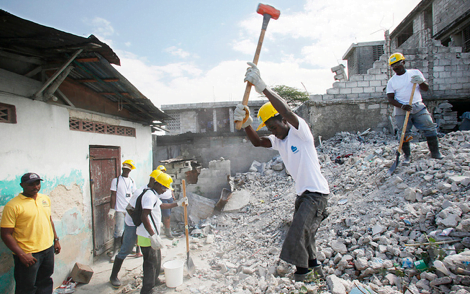The world commemorates the second anniversary of the devastating January 2010 earthquake on Thursday. There are a number of retrospectives, reports, and renewed media focus on Haiti this week. I thought it would be useful to give these stories some context by offering some facts and figures about the recovery.
Slowly but surely, displaced persons are moving out of camps
According to new UN figures, from July 2010 to November 2011, the number of people living in camps went down by over 65 percent, from 1.5 million to 520,000. The number of camps went from 1,555 in July 2010, to 758 in November 2011, a decrease of over 50%.
Cholera is still a very big concern
The sobering statistics. As of December 25, 2011, Haiti has reported 522,335 cases, 281,440 hospitalizations, and 7,001 deaths.
Can it be eradicated on the island of Hispaniola? Yes! says the U.S. Centers for Disease Control and Prevention, Pan American Health Organization, World Health Organization and UNICEF. In a new report, they draw a lesson from a Latin American Cholera epidemic in the 1990s that killed 10,000 people and infected over 1 million across 20 countries in two years. After a concerted, 8 year effort to improve sanitation, access to water and treatment, cholera had been eliminated from Latin America.
But how much will it cost? Estimated rough costs from the Inter-American Development Bank (IADB), the Office of the Haitian Prime Minister in Haiti, and the World Bank have ranged from $746 million to $1.1 billion.
Debris is being removed at a rapid clip.
From the UN peacekeeping mission: “More than 5 million cubic meters of debris have been cleared from the streets, half of the amount generated by the earthquake. The rate of clearance has been indisputably faster than in post-tsunami Aceh or at the post-9/11 World Trade Centre site. ”
International promises for reconstruction funds are (mostly) being met
According to the UN, of the $4.6 billion committed in March 2010 by donors to Haiti for 2010-2011, 88 percent of these funds have now been disbursed or committed.
Additional funding requirements
According to the UN Office for the Coordination of Humanitarian Affairs , “US $231 million will be required to address immediate unmet needs and carry out longer-term projects. More than $53 million will go towards providing better shelter and managing existing camps. Health, sanitation and hygiene projects will require some $68 million to carry out life-saving prevention and vaccination campaigns.”
We also have several excellent photos taken from a recent trip to Haiti by our friends at the UN Foundation. These photos tell part of the story of Haiti’s long recovery.
Children play soccer on ground that was previously occupied by tents at the partially-cleared displaced persons camp at Place Boyer in Port-au-Prince, Haiti, Wednesday, Jan. 4, 2012. Residents of the camp have been provided permanent housing and camp cleanup is in the final stages. Haiti approaches the second anniversary of the tragic earthquake that devastated the nation. (Photo/Stuart Ramson/Insider Images for UN Foundation)
A worker cleans a now-vacant Place St. Pierre, a former camp for displaced persons in Port-au-Prince, Haiti, Wednesday, Jan. 4, 2012. Residents of the camp were provided permanent housing in December and the park was the site of a holiday bazaar. (Photo/Stuart Ramson/Insider Images for UN Foundation)
A worker continues the cleanup of the partially-cleared displaced persons camp at Place Boyer in Port-au-Prince, Haiti, Wednesday, Jan. 4, 2012. Residents of the camp have been provided permanent housing and camp cleanup is in the final stages. (Photo/Stuart Ramson/Insider Images for UN Foundation)
A worker removes debris from the site of a collapsed home as part of a rubble removal project in the Port-au-Prince area of Bellaire, one the hardest hit neighborhoods in the earthquake that struck Haiti two years ago, Thursday, Jan. 5, 2012. The project is managed by the United Nations Development Program and the NGO Viva Rio. (Photo/Stuart Ramson/Insider Images for UN Foundation)
Workers remove debris from the site of a collapsed home as part of a rubble removal project in the Port-au-Prince area of Bellaire, one the hardest hit neighborhoods in the earthquake that struck Haiti two years ago, Thursday, Jan. 5, 2012. The project is managed by the United Nations Development Program and the NGO Viva Rio. (Photo/Stuart Ramson/Insider Images for UN Foundation)
A street market stretches to Port-au-Prince’s waterfront, creating vibrant commercial activity two years after the tragic earthquake in Haiti, Wednesday, Jan. 4, 2012. (Photo/Stuart Ramson/Insider Images for UN Foundation)






